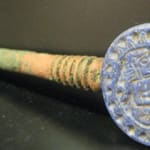Large Han Dynasty Painted Pottery Bull, 206 BCE - 220 CE
Terracotta
27.5 x 15.7
DL.2090
Further images
The overextension of the labor force during the Qin Dynasty would result in a popular uprising against the empire. In 206 B.C., Liu Bang, a Qin official, led an army...
The overextension of the labor force during the Qin Dynasty would result in a popular uprising against the empire. In 206 B.C., Liu Bang, a Qin official, led an army composed of peasants and some lower nobility to victory and established his own dynasty in place, the Han. However, unlike the Qin, the Han would unify China and rule virtually uncontested for over four hundred years. It is during this time that much of what is now considered to be Chinese culture was first actualized. The bureaucracy started under the Qin was now firmly established. The vast lands of China were now under the firm grip of a central authority. Confucianism became the state ideology although the worship of Taoist deity remained widespread, both among the peasants and the aristocracy. Ancient histories and texts were analyzed and rewritten to be more objective while new legendary myths and cultural epics were transcribed.
The Han era can also be characterized as one of the greatest artistic outpourings in Chinese history, easily on par with the glories of their Western contemporaries, Greece and Rome. Wealth, pouring into China from trade along the Silk Road, initiated a period of unprecedented luxury. Stunning bronze vessels were created, decorated with elegant inlaid gold and silver motifs. Jade carvings reached a new level of technical brilliance. But perhaps the artistic revival of the Han Dynasty is nowhere better represented than in their sculptures and vessels that were interred with deceased nobles. Called mingqi, literally meaning “spirit articles,” these works depicted a vast array of subject, from warriors and horses to ovens and livestock, which were buried alongside the dead for use in the next world, reflecting the Chinese belief that the afterlife was an extension of our earthly existence. Thus, quite logically, the things we require to sustain and nurture our bodies in this life would be just as necessary in our next life.
During the Han Dynasty, sculptural effigies of animals were often interred in the tombs of elite members of the social hierarchy. These sculptures were intended to accompany the spirit of the deceased. This sculpture of a bull is remarkable for its massive size. The Han culture believed that the afterlife was a continuation of our earthly existence. Thus, logically, as humans require food to nourish our bodies on earth, so too will we require food to nourish our souls in the afterlife. Originally, this sculpture featured removable horns and a tail that, unfortunately, have been lost to us over time. However, even in this incomplete state, the evocative nature of this sculpture is uncanny. The charming facial structure of this bull is so naturalistic that one feels the presence of the animal possessing this sculpture. Created to serve as food for the afterlife, this work is more than a mere sculpture; it is a gorgeous memorial to the religious and philosophical beliefs of the Han Dynasty.
The Han era can also be characterized as one of the greatest artistic outpourings in Chinese history, easily on par with the glories of their Western contemporaries, Greece and Rome. Wealth, pouring into China from trade along the Silk Road, initiated a period of unprecedented luxury. Stunning bronze vessels were created, decorated with elegant inlaid gold and silver motifs. Jade carvings reached a new level of technical brilliance. But perhaps the artistic revival of the Han Dynasty is nowhere better represented than in their sculptures and vessels that were interred with deceased nobles. Called mingqi, literally meaning “spirit articles,” these works depicted a vast array of subject, from warriors and horses to ovens and livestock, which were buried alongside the dead for use in the next world, reflecting the Chinese belief that the afterlife was an extension of our earthly existence. Thus, quite logically, the things we require to sustain and nurture our bodies in this life would be just as necessary in our next life.
During the Han Dynasty, sculptural effigies of animals were often interred in the tombs of elite members of the social hierarchy. These sculptures were intended to accompany the spirit of the deceased. This sculpture of a bull is remarkable for its massive size. The Han culture believed that the afterlife was a continuation of our earthly existence. Thus, logically, as humans require food to nourish our bodies on earth, so too will we require food to nourish our souls in the afterlife. Originally, this sculpture featured removable horns and a tail that, unfortunately, have been lost to us over time. However, even in this incomplete state, the evocative nature of this sculpture is uncanny. The charming facial structure of this bull is so naturalistic that one feels the presence of the animal possessing this sculpture. Created to serve as food for the afterlife, this work is more than a mere sculpture; it is a gorgeous memorial to the religious and philosophical beliefs of the Han Dynasty.





